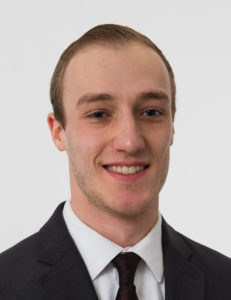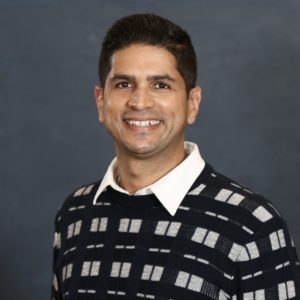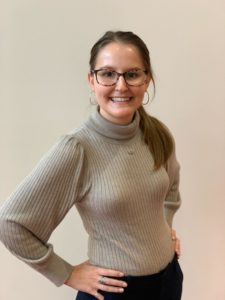In April 2022, the Society for Biomaterials held their annual meeting in Baltimore, USA. Journal of Materials Chemistry B and Materials Advances sponsored this event along with companion journal Biomaterials Science.
We would like to congratulate the winners of the SFB Three Minute Thesis Award. Check out the award winners and learn about their research in our interviews below.
Kevin Grassie: 1st Prize
1. What inspired you to go into your area of specific research?
I have always been passionate about science and surrounded by critical-thinkers;my parents and other family members have studied and/or worked in technological or scientific industries. I was taught at a young age to be curious about the world around us. Throughout high-school and during my undergraduate education at the University of Connecticut (UConn), I became eager to study a scientific field which sits at the intersection of my favorite disciplines: physics, mathematics, engineering, biology, and medicine. At the same time, my life-long athletic outlets in martial arts and acrobatic movements enhanced my curiosity in biomechanics and, through two injuries requiring surgery, gave me first-hand experience with clinical challenges in musculoskeletal health. Finally, in my undergraduate years at UConn, I took a tissue engineering class taught by Dr. Yusuf Khan (now my PhD advisor) that perfectly mixed all of my academic interests. These experiences all inspired me to pursue research in bone tissue/regenerative engineering, allowing me to integrate concepts from nearly every corner of science to find solutions to real-world, clinically-relevant problems.
2. What is one of the most rewarding things about your area of research?
One of the most rewarding aspects of my area of research is the collaborative and multidisciplinary nature of the work. I am very fortunate to be part of the Connecticut Convergence Institute for Translation in Regenerative Engineering at UConn Health, which offers a diverse group of faculty and students with wide-ranging expertise and technical skills. The days are never dull and there is always a lot to learn, which is exciting to me.
3. What are your next steps for your research/career?
In my research, the next steps are to dig deeper into the mechanotransduction events and osteogenic responses in hydrogel-encapsulated cells exposed to different types of low-intensity pulsed ultrasound stimulation. As for my career after my PhD, I am still undecided but considering the many possibilities that await. My several years as a tutor for college mathematics and physics have given me a strong desire to teach in some capacity, regardless of my career path. However, my primary goal is to stay connected to cutting-edge biomedical research, whether that be through academia, industry-based research-and-development, or government agencies/institutes such as NASA.
Gabriel Rodriguez- Rivera: 2nd Prize
1. What inspired you to go into your area of specific research?
Curiosity, possibilities, and opportunities. I worked in a biopharmaceutical company in Puerto Rico for seven years in the technology transfer of new products. Working at the interphase of development and commercialization sparked my interest in creating products that could impact the patient’s quality of life and using my tools as a chemical engineer to design and improve new biomaterials.
What is one of the most rewarding things about your area of research?
Being able to design a biomaterial that could eventually save and improve lives. Also, just seeing how we can use materials to induce a response in our bodies is incredible. Additionally, interacting with other scientists and clinicians with different areas of expertise helped me learn and grow.
What are your next steps for your research/career?
I am excited to continue understanding the fundamental properties of biomaterials for cardiovascular applications as a postdoc in Jason Burdick’s lab at the University of Colorado – Boulder.
Sarah Jones: 3rd Prize
What inspired you to go into your area of specific research?
I have always been interested in pursuing a career to improve human health, specifically by developing new techniques or products. However, my interest in biomedical engineering started quite broad. I initially imagined working on prosthetics or robotic surgical systems. However, once attending classes at Texas A&M University, I became increasingly interested in biomaterials and their ability interact with the human body. I joined the Grunlan Research Group and really discovered and developed a passion for materials-guided tissue regeneration. This is the idea that the chemistry/structure of an implanted material can guide tissue regeneration and healing without exogenous biologics. This field spoke to me as a way to sustainably and reliably enhance human health. This passion led me to the Cosgriff-Hernandez Lab at The University of Texas at Austin, focusing on polymeric materials for tissue engineering, to pursue my PhD in biomedical engineering. I hope to continue to develop and refine my passion for biomaterials throughout my education and career.
What is one of the most rewarding things about your area of research?
I believe the wide application of my research area is extremely rewarding. We spend so much time developing this wrap for a specific procedure for traumatic bone injuries. However, the things we learn from this process can be applied to almost any area of the body. Discovering structure property relationships and cell material interactions can contribute to the overall body of knowledge in biomedical engineering. For example, nutrient supply and blood flow is a common hurdle faced in all areas of tissue engineering, and my project has the potential to reveal a new technique to improve vascularization in new tissue.
What are your next steps for your research/career?
After completing my doctorate, I plan to continue in the field of biomaterials for tissue engineering. I hope to join the medical device industry as a research engineer and continually work to design and develop new products to aid in tissue regeneration.
Please join us in congratulating all the winners of the SFB Three Minute Thesis Award!













